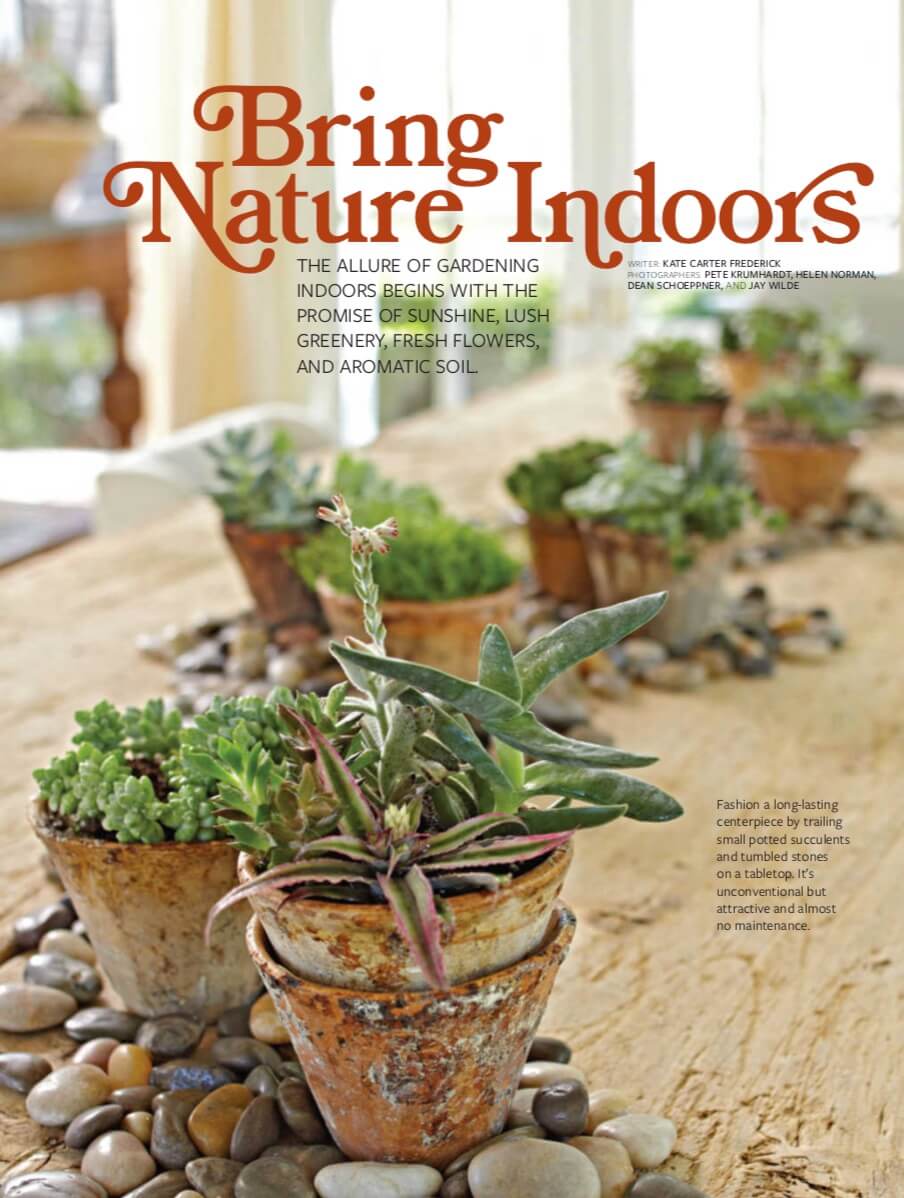[Ebook] Indoor Gardening Houseplants 2016 USA Magazine 2016 USA, Indoor Gardening Houseplants Magazine
[Ebook] Indoor Gardening Houseplants 2016 USA Magazine – II – Bring Nature Indoors (Đem thiên nhiên vào nhà)
- Dịch: Huyền Nguyễn
ENGLISH
THE ALLURE OF GARDENING INDOORS BEGINS WITH THE PROMISE OF SUNSHINE, LUSH GREENERY, FRESH FLOWERS, AND AROMATIC SOIL.
- WRITER: KATE CARTER FREDERICK
- PHOTOGRAPHERS: PETE KRUMHARDT, HELEN NORMAN, DEAN SCHOEPPNER, AND JAY WILDE
Fashion a long-lasting centerpiece by trailing small potted succulents and tumbled stones on a tabletop. It’s unconventional but attractive and almost no maintenance.
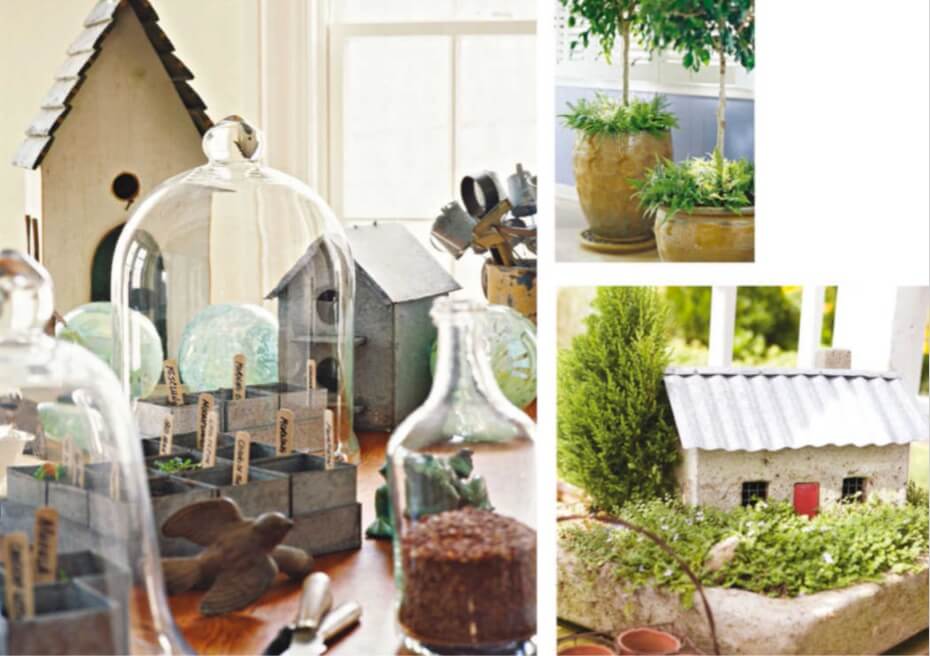
Joys of Gardening Indoors
The soul-soothing process of coaxing plants to grow in a sunny window keeps people close to nature, especially when winter wind rattles the glass and snow piles up outside the sill. Adding life, producing fresh air, and reducing indoor air pollution, plants make homes more livable. Watching seeds sprout and bulbs grow overnight brings the pride, joy, and astonishment that only nature inspires.
With nothing more than potted plants, you can create a fragrant, blooming indoor haven that is every bit as pleasurable as a conventional garden. Gardening indoors isn’t the same as digging into a yard. But it enables you to garden if your home has no yard or when the climate forces you indoors. Everyone has a reason for gardening, whether it’s a passion for plants, solace, entertainment, artistic inspiration, personal satisfaction, religion, or way of life. The sheltering walls and sunny windows indoors make it possible—whatever the weather. Although indoor gardening trends come and go—from macramé plant hangers to the latest craze over air plants—enthusiasm for tropical plants persists and tried-and-true houseplants remain. New hybrids of houseplants with tropical origins prove easier to grow with less light and little maintenance. Sturdy Anthuriumand indestructible Sansevieria join the adaptable ZZ plants in the easy-growing category. New color patterns of Chinese evergreens and dracenas turn houseplants into home decor accessories. A trip to the grocery or building supply store can expand your indoor gardening horizon when you bring home an unexpected orchid or other blooming treasure. Once hard-to-find plants are now common and affordable.
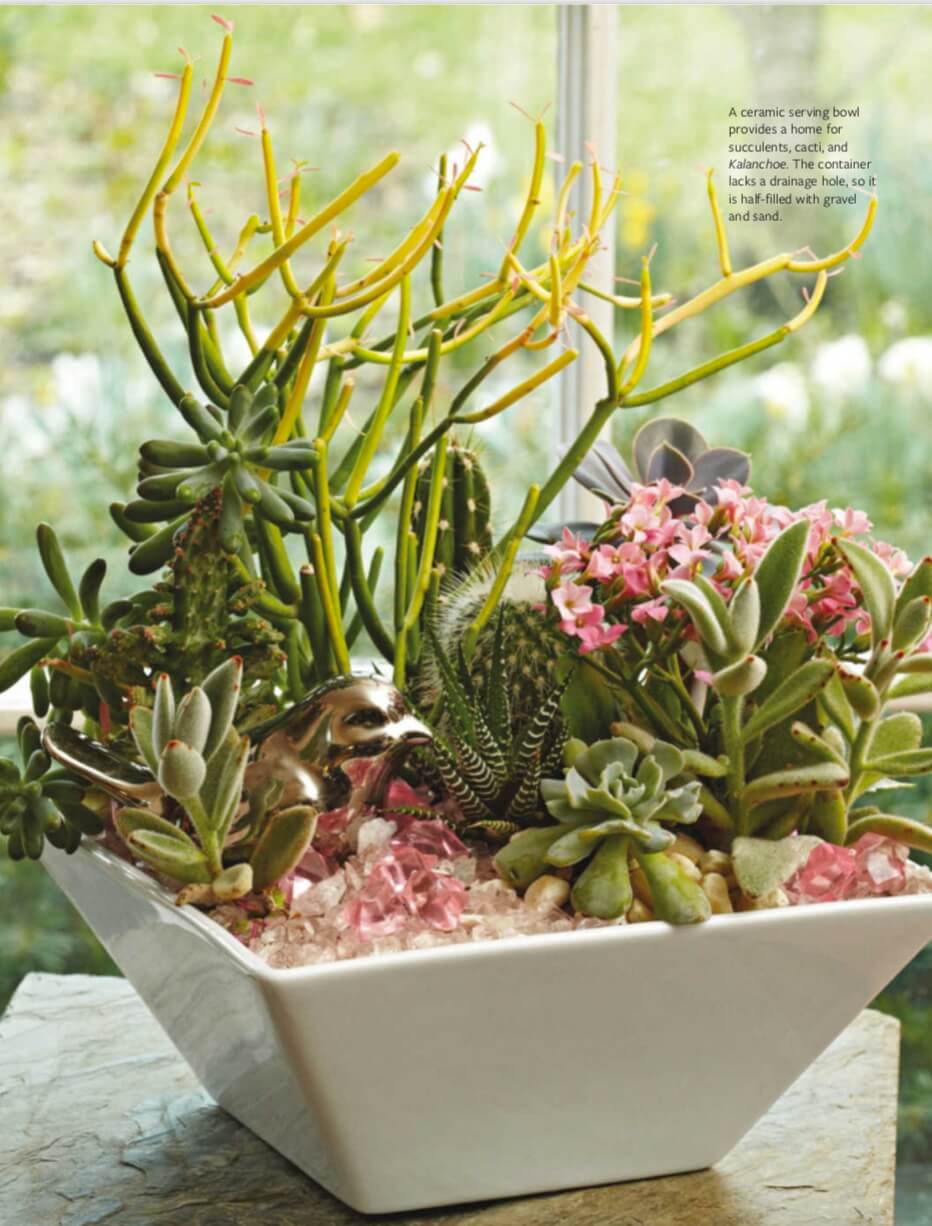
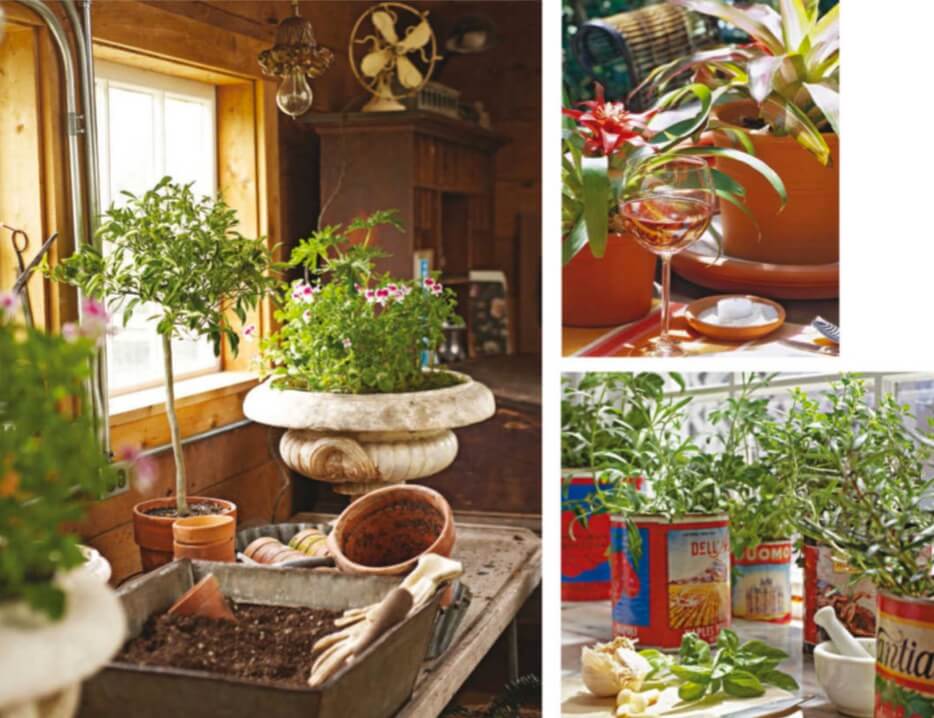
Year-round Gardening
Gardening indoors is just the right antidote to cabin fever when winter keeps people housebound. For the veteran grower, winter signals neither the end of the gardening season nor the only time for indoor gardening, but simply the start of another cycle. Some newbie plant handlers might wince at the thought of keeping plants alive indoors. But a single flowering plant, even kept only temporarily, provides encouragement rather than demands.
An indoor garden brings spring to the frozen North and creates jungles in the desert. After all, a home gardener can control the climate indoors. And fortunately for the gardener, plants have no idea whether they are growing in a guest room or a greenhouse. All they need is a smattering of sun, a dependable supply of water, reasonably benevolent temperatures, adequate nutrients, and a whiff of fresh air now and then. No matter where you live, you can have fresh herbs and other edibles indoors year-round with natural or supplemental light or both.
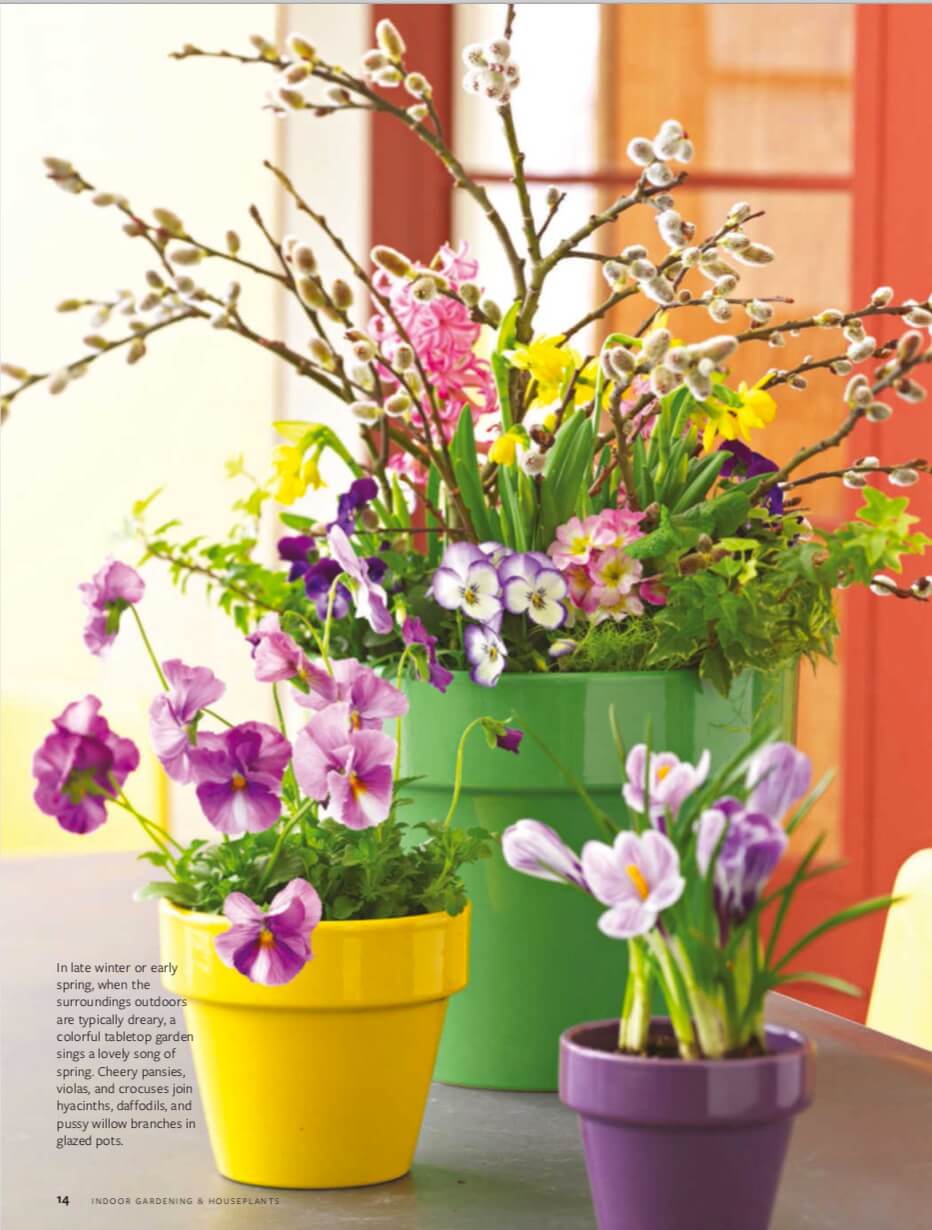
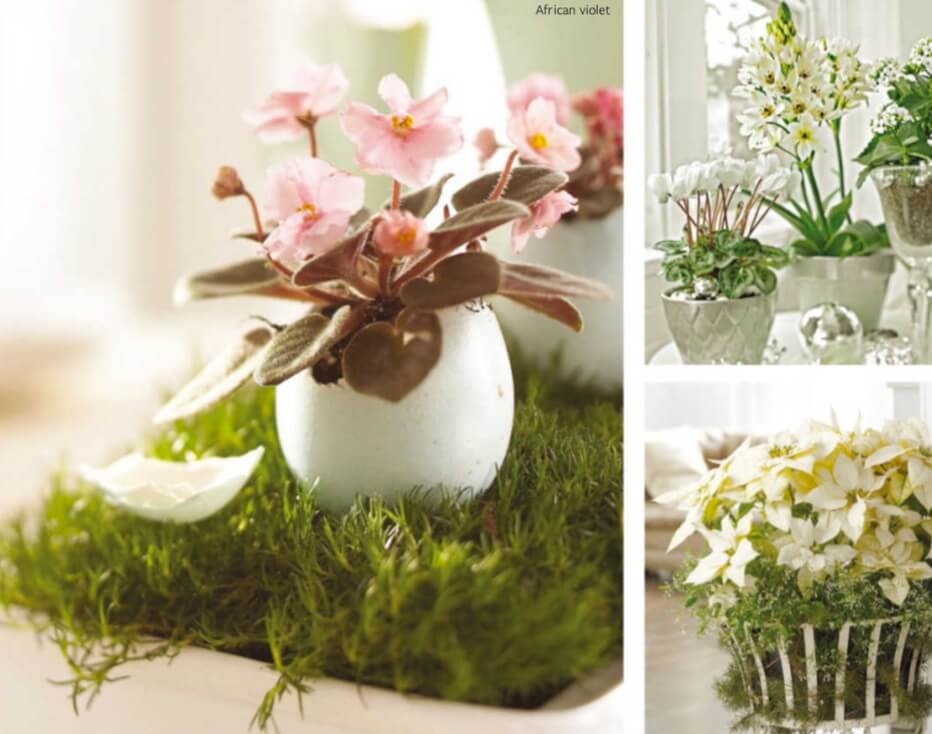
It’s a Gift
As a long-lasting and cheerful gift, a plant is sure to please. A large potted amaryllis bulb will flower dependably and sometimes perform spectacularly with successive blooms in exchange for only occasional watering. Whether the recipient is a gardener or not, a plant is intended as a token that lasts longer than cut flowers. Any plant, from the smallest herb to the largest ornamental tree, helps extend the gardening year.
Plants add color, fragrance, and timeless appeal to some of life’s most memorable moments. Seasonal beauties bring symbolic connections to holidays and form an integral part of traditions. For example, as a Thanksgiving cactus cherished by generations of a family reblooms annually, it reminds them of those who have passed and shared their penchant for gardening with heirloom cuttings. Poinsettias and tabletop evergreen trees add to winter celebrations with their festive charms. Easter lilies trumpet spring; chrysanthemums complete autumn gatherings. Flowering bulbs create a season-to-season parade, including winter amaryllis, daffodils, lilies, and autumn crocuses.
Typically, seasonal plants are grown in the ideal conditions of a greenhouse and forced into bloom at a time not in sync with their natural growth and life cycle. Some specialty plants last only a few weeks; others live on for months or even years.
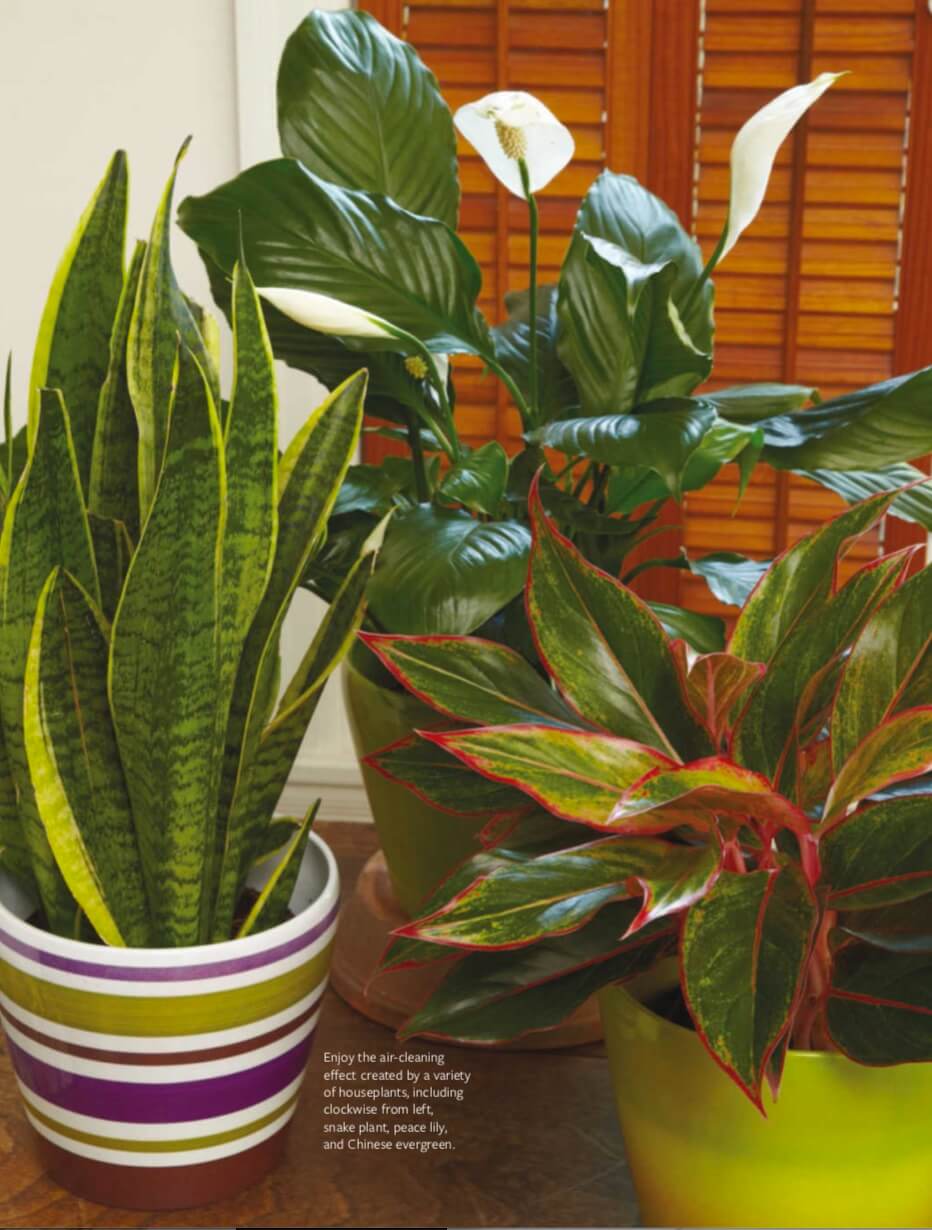
Healthful Houseplants
At home and in public spaces, plants enhance mental, physical, and social health. As people spend less time outdoors breathing fresh air, indoor plants counteract the negative effects of the pattern by boosting oxygen and moderating humidity to more natural levels. People who work with or near plants and flowers have lower blood pressure, less stress, reduced depression, and an increased sense of well-being. Scientific research bears out these and other benefits of sharing indoor spaces with plants.
The Environmental Protection Agency ranks indoor air pollution as one of the top threats to health. In our increasingly energy-efficient houses and office buildings, there exists an unhealthy lack of fresh air and a preponderance of pollutants. Synthetic furnishings and building materials that release toxic chemicals add to the problem. Volatile organic compounds (VOCs) that form toxic vapors at room temperature are commonly found in plastics, cleaning products, and other household chemicals.
Research by NASA has proved that an array of houseplants reduce indoor pollutants by filtering them as well as particulate matter from the air. The NASA study suggests that as few as 15 houseplants can reduce the pollutants in an average home. All it takes is one potted plant per 100 square feet to clean the air in an average size house or office.
Generally, plants with large leaves have higher rates of transpiration and an increased ability to reduce toxins. Gerbera daisies and mums top the list of flowering plants most effective as air filters.
Nature’s Air Filters
Houseplants add more than a welcome touch of greenery to homes and offices—they also reduce common indoor air pollutants. The following include some of the air-cleaning plants and chemicals they filter most effectively.
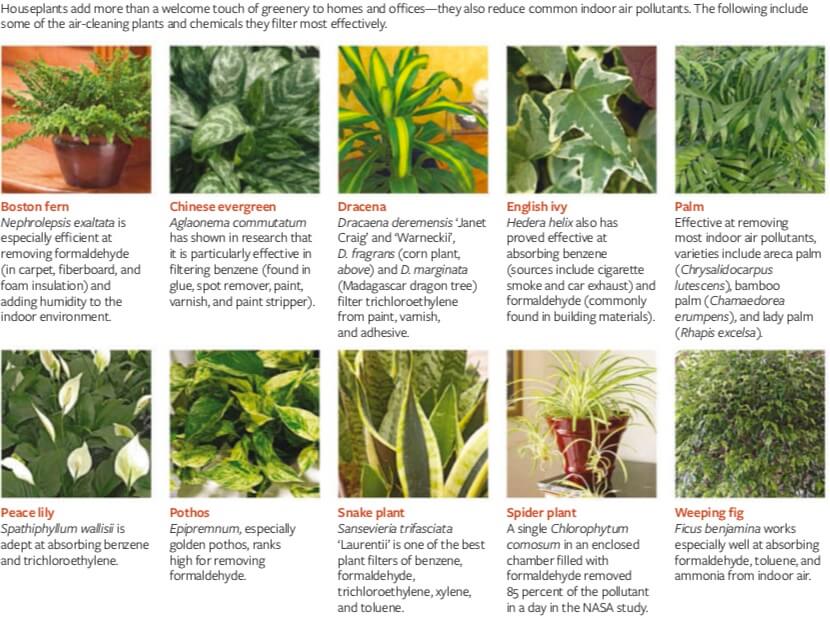
- Boston fern: Nephrolepsis exaltata is especially efficient at removing formaldehyde (in carpet, fiberboard, and foam insulation) and adding humidity to the indoor environment.
- Chinese evergreen: Aglaonema commutatum has shown in research that it is particularly effective in filtering benzene (found in glue, spot remover, paint, varnish, and paint stripper).
- Dracena: Dracaena deremensis ‘Janet Craig’ and Dracaena ‘Warneckii’, Dracaena fragrans (corn plant, above) and Dracaena (Madagascar dragon tree) filter trichloroethylene from paint, varnish, and adhesive.
- Snake plant: Sansevieria trifasciata ‘Laurentii’ is one of the best plant filters of benzene, formaldehyde, trichloroethylene, xylene, and toluene.
- English ivy: Hedera helix also has proved effective at absorbing benzene (sources include cigarette smoke and car exhaust) and formaldehyde (commonly found in building materials).
- Palm: Effective at removing most indoor air pollutants, varieties include Areca palm (Chrysalidocarpus lutescens, Dypsis lutescens), bamboo palm (Chamaedorea erumpens), and lady palm (Rhapis excelsa).
- Weeping fig: Ficus benjamina works especially well at absorbing formaldehyde, toluene, and ammonia from indoor air.
- Peace lily: Spathiphyllum wallisii is adept at absorbing benzene and trichloroethylene.
- Pothos: Epipremnum, especially Golden pothos, ranks high for removing formaldehyde.
- Spider plant: A single Chlorophytum comosum in an enclosed chamber filled with formaldehyde removed 85 percent of the pollutant in a day in the NASA study.
TIẾNG VIỆT
QUÁ TRÌNH LÀM VƯỜN TRONG NHÀ KHỞI ĐẦU VỚI ÁNH NẮNG MẶT TRỜI, CÂY XANH, HOA TƯƠI VÀ ĐẤT TRỒNG.
- TÁC GIẢ: KATE CARTER FREDERICK
- ẢNH: PETE KRUMHARDT, HELEN NORMAN, DEAN SCHOEPPNER VÀ JAY WILDE
Tạo nên một giá trị lâu dài bằng cách trồng những cây mọng nước (succulents) nhỏ trong chậu với những viên đá và đặt trên mặt bàn. Nó độc đáo, hấp dẫn và hầu như không cần chăm sóc.

Niềm vui làm vườn trong nhà
Cây mọc bên khung cửa sổ đầy nắng xoa dịu tâm hồn và giúp con người gần gũi với thiên nhiên, nhất là khi mùa đông gió thổi mạnh và tuyết chất thành đống bên ngoài ngưỡng cửa. Thêm sức sống, tạo ra không khí trong lành và giảm ô nhiễm không khí trong nhà, cây cối làm cho ngôi nhà trở nên đáng sống hơn. Nhìn hạt giống nảy mầm và củ lớn lên qua đêm mang lại niềm tự hào, niềm vui và sự ngạc nhiên mà chỉ thiên nhiên mới có.
Không có gì khác ngoài những chậu cây, bạn có thể tạo ra một nơi trú ẩn trong nhà thơm ngát, rực rỡ và thú vị như một khu vườn thông thường. Làm vườn trong nhà không giống như trồng cây ngoài sân, nhưng nếu nhà bạn không có sân hoặc khi khí hậu buộc bạn phải ở trong nhà thì giải pháp chính là làm vườn trong nhà. Mọi người đều có lý do để làm vườn, cho dù đó là niềm đam mê với cây cối, niềm an ủi, giải trí, cảm hứng nghệ thuật, sự hài lòng cá nhân, tôn giáo hay lối sống. Những bức tường che chắn và cửa sổ đầy nắng trong nhà giúp bạn có thể làm điều đó bất kể thời tiết. Mặc dù xu hướng làm vườn trong nhà thay đổi theo thời gian, từ giá treo cây macramé đến cơn sốt mới nhất về cây không khí, tình yêu đối với cây nhiệt đới vẫn tồn tại và những cây trồng trong nhà vẫn còn được thử nghiệm. Các giống cây trồng lai mới có nguồn gốc nhiệt đới dễ trồng hơn trong môi trường có ít ánh sáng và ít phải chăm sóc. Cây Hồng Môn (Sturdy Anthuriumand), cây Lưỡi Hổ (Sansevieria) và cây Kim Tiền (ZZ plant) là những loại cây cứng cáp và dễ trồng. Các mẫu màu mới của giống cây Thường Xuân Trung Quốc (Chinese evergreens) biến cây trồng trong nhà thành phụ kiện trang trí nhà. Một chuyến đi đến cửa hàng tạp hóa hoặc cửa hàng cung cấp vật liệu xây dựng có thể mở rộng chân trời làm vườn trong nhà của bạn khi bạn mang về nhà một loài Phong Lan (orchid) bất ngờ hoặc một loài hoa nở rộ khác. Những loại cây khó kiếm một thời nay đã trở nên phổ biến và có giá cả phải chăng.


Làm vườn quanh năm
Làm vườn trong nhà chỉ là liều thuốc giải độc phù hợp cho cơn sốt cabin khi mùa đông khiến mọi người luôn ở trong nhà. Đối với người trồng cây lâu năm, mùa đông không báo hiệu sự kết thúc của mùa làm vườn cũng không phải là thời điểm duy nhất để làm vườn trong nhà, mà chỉ đơn giản là sự bắt đầu của một chu kỳ khác. Một số người mới trồng cây có thể sẽ nao núng khi nghĩ đến việc giữ cho cây sống trong nhà. Nhưng một cây hoa duy nhất, thậm chí chỉ được giữ lại tạm thời, mang lại sự khích lệ hơn là nhu cầu.
Một khu vườn trong nhà mang đến mùa xuân cho miền Bắc băng giá và tạo ra những khu rừng trên sa mạc. Rốt cuộc, một người làm vườn tại nhà có thể kiểm soát khí hậu trong nhà. Và may mắn thay cho người làm vườn, cây không biết chúng đang phát triển trong phòng khách hay trong nhà kính. Tất cả những gì chúng cần là ánh nắng chói chang, nguồn nước chất lượng, nhiệt độ hợp lý, đầy đủ chất dinh dưỡng và một luồng không khí trong lành. Bất kể bạn sống ở đâu, bạn có thể trồng các loại thảo mộc tươi và các loại phù du khác trong nhà quanh năm với ánh sáng tự nhiên hoặc ánh sáng nhân tạo, hoặc cả hai.


Đó là một món quà
Là một món quà lâu dài và thú vị, cây xanh chắc chắn sẽ làm hài lòng những ai nhận được món quà ý nghĩa này. Một củ hoa Loa Kèn đỏ (amaryllis) trong chậu lớn sẽ ra hoa tùy thuộc và đôi khi mang vẻ đẹp ngoạn mục với các đợt nở liên tiếp chỉ cần bạn tưới nước thường xuyên. Cho dù người nhận có phải là người làm vườn hay không, thì một loại cây sẽ tồn tại lâu hơn hoa cắt cành. Bất kỳ loại cây nào, từ các loại thảo mộc nhỏ nhất đến cây cảnh lớn nhất, đều có thể sống tốt trong cả năm.
Thực vật tạo thêm màu sắc, hương thơm và sức hấp dẫn vượt thời gian cho những khoảnh khắc đáng nhớ nhất của cuộc đời. Vẻ đẹp theo mùa mang đến sự kết nối biểu tượng cho các ngày lễ và tạo thành một phần không thể thiếu trong truyền thống. Ví dụ, một cây Xương Rồng (Cactus) trong Lễ Tạ Ơn được các thế hệ trong gia đình nâng niu chăm sóc để nở hoa hàng năm, cây nhắc nhở họ về những người đã chia sẻ cây cho họ. Cây Trạng Nguyên và những cây Thường Xanh trên mặt bàn làm tăng thêm sức hấp dẫn cho lễ hội mùa đông, hoa Loa Kèn mùa xuân và hoa Cúc mùa thu. Các củ cây ra hoa và khoe sắc theo mùa, bao gồm hoa Loa Kèn đỏ (amaryllis) mùa đông, hoa Thủy Tiên vàng (daffodil) và hoa Râm Bụt mùa thu (crocuse).
Thông thường, các loại cây theo mùa được trồng trong điều kiện lý tưởng của nhà kính và buộc phải nở hoa vào thời điểm không giống với sự phát triển tự nhiên và chu kỳ sống của chúng. Một số loại cây đặc biệt chỉ tồn tại trong vài tuần, một số cây khác có thể sống trong nhiều tháng hoặc thậm chí nhiều năm.

Cây trong nhà tốt cho sức khỏe
Ở nhà và những nơi công cộng, cây trồng giúp tăng cường sức khỏe tinh thần, thể chất và xã hội. Khi mọi người dành ít thời gian ở ngoài trời để hít thở không khí trong lành, cây trồng trong nhà chống lại những tác động tiêu cực bằng cách tăng cường oxy và điều chỉnh độ ẩm đến mức tự nhiên hơn. Những người làm việc trong môi trường gần cây và hoa có huyết áp thấp hơn, ít căng thẳng hơn, giảm trầm cảm và tăng cảm giác hạnh phúc. Nghiên cứu khoa học chỉ ra những lợi ích này và những lợi ích khác của việc trồng cây trong nhà.
Cơ quan Bảo vệ Môi trường xếp hạng ô nhiễm không khí trong nhà là một trong những mối đe dọa hàng đầu đối với sức khỏe. Trong các ngôi nhà và tòa nhà văn phòng ngày càng tiết kiệm năng lượng của chúng ta, luôn tồn tại tình trạng thiếu không khí trong lành và có các chất ô nhiễm không tốt. Nội thất tổng hợp và vật liệu xây dựng thải ra các hóa chất độc hại càng làm tăng thêm vấn đề. Các hợp chất hữu cơ dễ bay hơi (VOC) tạo thành hơi độc ở nhiệt độ phòng thường được tìm thấy trong nhựa, sản phẩm tẩy rửa và các hóa chất gia dụng khác.
Nghiên cứu của NASA đã chứng minh rằng một loạt các cây trồng trong nhà làm giảm các chất ô nhiễm và các chất dạng hạt từ không khí trong nhà bằng phương pháp lọc. Nghiên cứu của NASA cho thấy rằng chỉ có 15 cây trồng trong nhà có thể làm giảm các chất ô nhiễm ở mức trung bình trong một ngôi nhà. Tất cả những gì chúng ta cần là một chậu cây trên 100 feet vuông để làm sạch không khí trong một ngôi nhà hoặc văn phòng có diện tích trung bình.
Nói chung, cây có lá lớn có tỷ lệ thoát hơi nước cao hơn và tăng khả năng khử độc tố. Cúc Đồng Tiền (Gerbera daisies) và hoa Cúc (mums) đứng đầu danh sách những loài thực vật có hoa có tác dụng lọc không khí hiệu quả nhất.
Bộ lọc không khí của thiên nhiên
Cây xanh trong nhà không chỉ mang đến sắc xanh cho ngôi nhà và văn phòng, chúng còn làm giảm các chất ô nhiễm không khí thông thường trong nhà. Sau đây là một số loại cây làm sạch không khí và hóa chất hiệu quả nhất.

- Cây Dương Xỉ Boston (Boston fern): Nephrolepsis exaltata đặc biệt hiệu quả trong việc loại bỏ formaldehyde có trong thảm, ván sợi và vật liệu cách nhiệt bằng bọt và tăng thêm độ ẩm cho môi trường trong nhà.
- Cây Thường Xanh Trung Quốc (Chinese evergreen): Aglaonema commutatum đặc biệt hiệu quả trong việc lọc benzen (có trong keo, chất tẩy, sơn, véc ni và máy tẩy sơn).
- Thiết Mộc Lan (Dracena): Dracaena deremensis ‘Janet Craig’ và Dracaena ‘Warneckii’, Dracaena aromans (cây Ngô) và Dracaena (cây Rồng Madagascar) giúp lọc trichloroethylen khỏi sơn, véc ni và chất kết dính.
- Cây Lưỡi Hổ (Snake plant): Sansevieria trifasciata ‘Laurentii’ là một trong những loại thực vật lọc benzen, formaldehyde, trichloroethylene, xylen và toluene tốt nhất.
- Cây Thường Xuân (English ivy): Hedera helix cũng đã chứng minh hiệu quả trong việc hấp thụ benzen trong khói thuốc lá và khói xe và formaldehyde (thường được tìm thấy trong vật liệu xây dựng).
- Cây Cọ (Palm): Có hiệu quả trong việc loại bỏ hầu hết các chất gây ô nhiễm không khí trong nhà, các giống bao gồm Cọ Cau (Chrysalidocarpus lutescens, Dypsis lutescens), Cọ Tre (Chamaedorea erumpens) và Cọ Trúc Mây (Rhapis excelsa).
- Cây Sung (Weeping fig): Ficus benjamina hoạt động đặc biệt tốt trong việc hấp thụ formaldehyde, toluen và amoniac từ không khí trong nhà.
- Hoa Huệ Hòa Bình (peace lily): Spathiphyllum wallisii rất tốt trong việc hấp thụ benzen và trichloroethylene.
- Cây Trầu Bà (Pothos): Epipremnum, đặc biệt là Trầu Bà lá vàng (Golden pothos), xếp hạng cao trong việc loại bỏ formaldehyde.
- Cỏ Lan Chi (Spider plant): Cây Chlorophytum comosum trong một buồng kín chứa đầy formaldehyde đã loại bỏ 85% chất ô nhiễm trong một ngày trong nghiên cứu của NASA.

